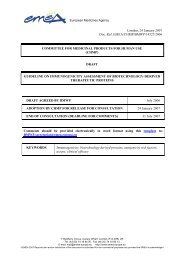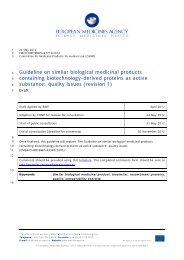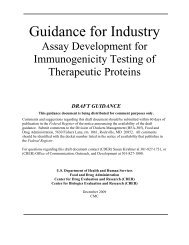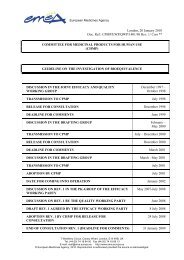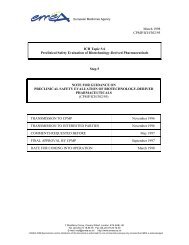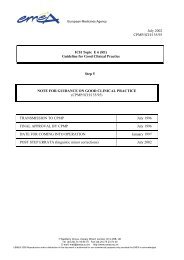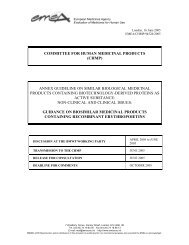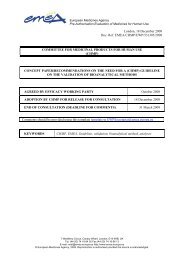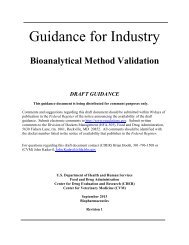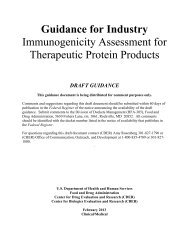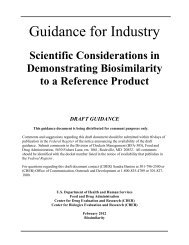Guidance for Industry - Assay Development
Assay Development for Immunogenicity Testing of Therapeutic Proteins, Draft Guidance http://www.ipm-biotech.de/fileadmin/user_upload/pdf/guidelines/FDA-GUIDANCE-Assay-Development-Immunogenicity-Testing.pdf
Assay Development for Immunogenicity Testing of Therapeutic Proteins, Draft Guidance
http://www.ipm-biotech.de/fileadmin/user_upload/pdf/guidelines/FDA-GUIDANCE-Assay-Development-Immunogenicity-Testing.pdf
Create successful ePaper yourself
Turn your PDF publications into a flip-book with our unique Google optimized e-Paper software.
564<br />
565<br />
566<br />
567<br />
568<br />
569<br />
570<br />
571<br />
572<br />
573<br />
574<br />
575<br />
576<br />
577<br />
578<br />
579<br />
580<br />
581<br />
582<br />
583<br />
584<br />
585<br />
586<br />
587<br />
588<br />
589<br />
590<br />
591<br />
592<br />
593<br />
594<br />
595<br />
596<br />
597<br />
598<br />
599<br />
600<br />
601<br />
602<br />
603<br />
604<br />
605<br />
606<br />
607<br />
Contains Nonbinding Recommendations<br />
Draft — Not <strong>for</strong> Implementation<br />
testing. Freezing and thawing patient samples may also affect assay results and those assay<br />
results should be evaluated. In addition, the applicant should examine other parameters affecting<br />
patient samples such as state of hemolysis and specific anticoagulants. Other considerations may<br />
include state of lipemia, presence of bilirubin, and presence of concomitant medications that a<br />
patient population may be using. The applicant should examine robustness during the<br />
development phase and if small changes in specific steps in the assay affect results, specific<br />
precautions should be taken to control their variability.<br />
B. Validation of Neutralizing <strong>Assay</strong><br />
1. Sensitivity<br />
The approach to demonstrating the sensitivity of the neutralization assay is similar to that of the<br />
binding assay. The applicant should report the sensitivity in mass units. FDA recognizes that<br />
not all anti-product antibodies are neutralizing and it can be difficult to identify positive control<br />
antibodies with neutralizing capacity. Nonetheless, such reagents are critical <strong>for</strong> demonstrating<br />
assay sensitivity.<br />
The concentration of product employed in the neutralizing assay is also critical as discussed<br />
above. FDA recommends that the concentration of product used be on the linear region of the<br />
dose response curve <strong>for</strong> the product. FDA recognizes that while the use of low concentrations of<br />
product may lead to a neutralizing assay that is more sensitive to inhibition by antibodies, very<br />
low concentration of product may result in poor precision of the assay. Another feature of<br />
neutralizing assays is that they are often less sensitive than binding assay. While this limitation<br />
is noted, sponsors are encouraged to develop the most sensitive assays possible.<br />
2. Specificity<br />
Applicants should demonstrate assay specificity <strong>for</strong> cell based neutralizing assays. As<br />
mentioned above, <strong>for</strong> cells that may be responsive to stimuli other than the specific therapeutic<br />
protein, the ability to demonstrate that NAB only inhibit the response to product and not to other<br />
stimuli is a good indication of assay specificity. In such studies FDA recommends that the other<br />
stimuli be employed at a concentration that yields an outcome similar to that of the therapeutic<br />
protein. The applicant should also confirm the absence of alternative stimuli in patient serum.<br />
3. Precision<br />
<strong>Assay</strong> precision can also be more problematic <strong>for</strong> neutralizing assays than binding assays.<br />
Biologic responses can be inherently more variable than carefully controlled binding studies.<br />
Consequently, the applicant should per<strong>for</strong>m more replicates <strong>for</strong> assessment of precision and<br />
assessment of patient responses than <strong>for</strong> the screening assay.<br />
4. Other Elements of Neutralizing <strong>Assay</strong> Validation<br />
C:\8495dft.doc<br />
11/4/09<br />
14




